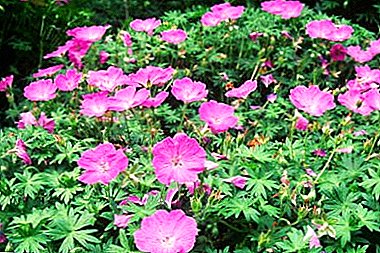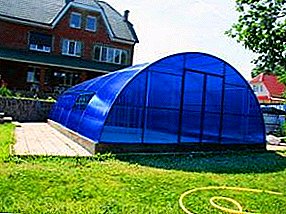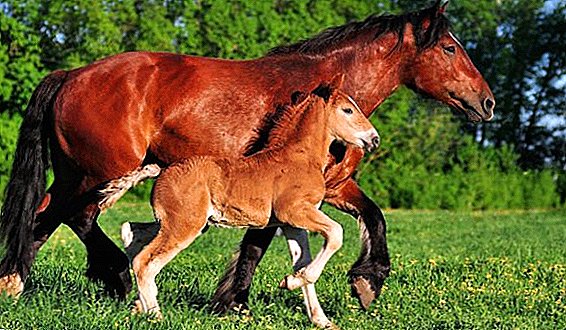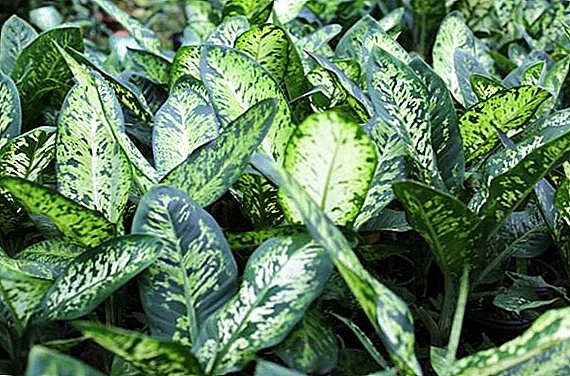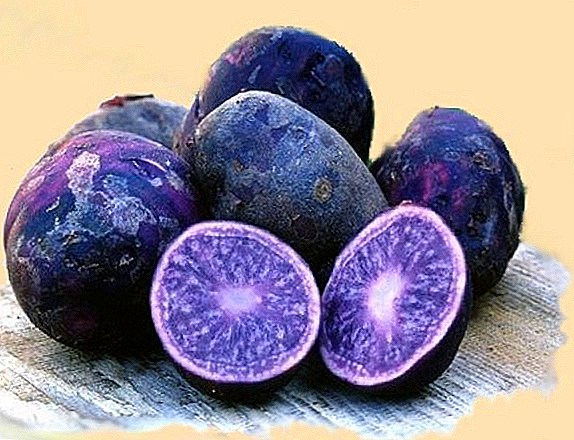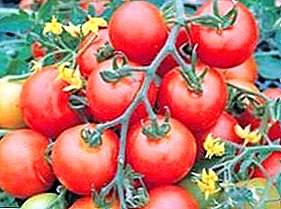
The first generation hybrids are characterized by good yield, endurance, resistance to common diseases of tomatoes.
All these qualities are inherent in the snowfall variety. It is suitable for open ground, greenhouses and greenhouses. It does not require excessive care, but it needs a constant staining of the bushes.
You will find a full description of the variety, its main characteristics and cultivation features in our article. And also learn everything about possible diseases and potential pests.
Tomato Snowfall f1: description of the variety
| Grade name | F1 snowfall |
| general description | Late, indeterminate variety of tomatoes for growing in greenhouses and open ground. |
| Originator | Transnistrian NIISH. |
| Ripening | 120-150 days |
| The form | Fruits are rounded, slightly ribbed to the stem. |
| Colour | The color of ripe fruit is red. |
| Average tomato mass | 60-75 grams |
| Application | Good for fresh use, for salting and canning. |
| Yield varieties | 4-5 kg from 1 plant |
| Features of growing | 50 x 40 cm, 3-4 plants per 1 square meter. |
| Disease resistance | Resistant to TMV, slightly affected by anthracnose and Alternaria. |
Tomato Snowfall F1 is a first-generation late-ripening high-yielding hybrid. Indeterminate shrub, up to 2 m high. About determinantal, semi-determinant and superdeterminant varieties can be found here.
The plant is moderately sprawling, with abundant green mass, requiring mandatory formation. Leaves are medium-sized, simple. Fruits ripen by brushes of 8-10 pieces. Productivity is good, you can collect at least 4-5 kg of selected tomatoes from a bush.
You can compare the yield of a variety with others in the table below:
| Grade name | Yield |
| Snowfall | 4-5 kg per square meter |
| Nastya | 10-12 kg per square meter |
| Gulliver | 7 kg from a bush |
| Honey heart | 8.5 kg per square meter |
| Broody | 10-1 kg per square meter |
| Lazy man | 15 kg per square meter |
| Buyan | 9 kg from a bush |
| Black bunch | 6 kg from a bush |
| King of the market | 10-12 kg per square meter |
| De barao giant | 20-22 kg from a bush |
| Rocket | 6.5 kg per square meter |
On other high-yielding varieties, plus also disease-resistant, read here.
Tomatoes are medium in size, weighing 80-130 g. The shape is flat-rounded, with slight ribbing at the stem. The color of ripe tomatoes is rich red. The skin is thin, well protecting the fruit from cracking.
Pulp moderately dense, juicy, fleshy, with a small amount of seeds. Taste is pleasant, saturated, sweetish, aroma is delicate. High sugar content makes tomatoes ideal for baby food and cooking various dishes.
The information in the table below will help to compare the weight of the fruits of this variety with others:
| Grade name | Fruit weight |
| Snowfall | 60-75 grams |
| Altaic | 50-300 grams |
| Yusupovskiy | 500-600 grams |
| Prime minister | 120-180 grams |
| Andromeda | 70-300 grams |
| Stolypin | 90-120 grams |
| Red bunch | 30 grams |
| Lazy man | 300-400 grams |
| Nastya | 150-200 grams |
| Honey heart | 120-140 grams |
| Mazarin | 300-600 grams |
Origin and Application
Tomato variety Snowfall bred by Russian breeders, suitable for different regions. Depending on the climatic conditions, it is possible to grow in a greenhouse, a greenhouse, or in open beds. Harvested tomatoes are well kept, transportation is possible.
Tomatoes Snowfall f1 tasty fresh, suitable for cooking salads, soups, side dishes, mashed potatoes, sauces. Small, robust tomatoes are suitable for whole-canning. Ripe tomatoes make a delicious juice, which you can drink freshly squeezed or prepared for future use.
Advantages and disadvantages
Among the main advantages of the variety:
- tasty and beautiful fruits;
- good yield;
- harvested tomatoes are well kept;
- disease resistance.
In detail about the diseases of tomatoes, which are subject to greenhouse plants, read here. We will also tell you about how to deal with them.
Among the shortcomings can be noted the need for constant staking. If the side shoots are not removed, the landings quickly turn into the jungle, and the yield is noticeably reduced. Another disadvantage is the inability to collect seeds for subsequent plantings, the tomatoes grown from them will not have the qualities of a mother plant.
A photo
In the photo you can see the varieties of snowfall tomatoes f1:



Features of growing
 Seeds are sown on seedlings in the second half of March. The soil should be nutritious and light, consisting of a mixture of garden or turf land with humus. You can add a little washed river sand to the substrate. How to properly prepare for planting in the spring, read here.
Seeds are sown on seedlings in the second half of March. The soil should be nutritious and light, consisting of a mixture of garden or turf land with humus. You can add a little washed river sand to the substrate. How to properly prepare for planting in the spring, read here.
Seeds are sown with a depth of 1-1.5 cm, sprayed with water and covered with foil. You can use special greenhouses for seedlings. Perhaps planting seeds in individual peat pots, in this case, do not need a pick of young plants. To accelerate the process, you can apply various growth promoters.
Tomatoes need bright sunlight or artificial light, a temperature not higher than 22 degrees, moderate watering with warm water. Cold can not be used, it causes shock in plants.
After the appearance of the first pair of true leaves, the seedlings are diving and then fed with a liquid complex fertilizer. Feed will be required further in the process of growing. Read about how to properly use for this purpose organic fertilizers, iodine, ammonia, hydrogen peroxide, yeast. And also find out why tomatoes boric acid.
A week before transplanting young tomatoes begin to harden. They are taken out to the balcony or veranda, first for a few hours and then for the whole day. Seedlings are transplanted into the greenhouse in the second half of May; it can be moved to open beds closer to the beginning of June. On 1 square. m is placed no more than 3 bushes, immediately after transplantation begins the formation of plants.
Ideal - the formation of a bush in 1-2 stems, with the constant removal of stepsons. Tall bushes are conveniently tied to the trellis, as the fruit ripens, branches with fruits are attached to it. During the planting season, 3-4 times feed up with a full complex fertilizer, which can be alternated with a diluted mullein.
Mulching will help in weed control.
Diseases and pests: prevention and control methods
Like other hybrids, Tomato Snowfall is resistant to the main diseases of the nightshade. About varieties with the same trait read here. And in this article you will find information about tomatoes that do not suffer from late blight.
Snowfall is almost not affected by mosaics, Fusarium, Verticillus. From the epidemic of phytophthora, tomatoes will save abundant sprays of copper-containing preparations. The affected parts of plants are quickly destroyed.
Industrial insecticides or decoctions of celandine and onion peel will help to get rid of insect pests. They are effective against flying insects, aphids, larvae of the Colorado beetles.
 On our website you can get acquainted with the varieties of tomatoes, the most resistant to various diseases of the nightshade.
On our website you can get acquainted with the varieties of tomatoes, the most resistant to various diseases of the nightshade.And also learn what the indeterminant varieties differ from the determinant varieties.
Snowfall is a promising, unpretentious and fruitful hybrid. By planting several bushes in your garden, you can collect fruit from mid-summer to the end of the season.
We also bring to your attention useful materials on how to grow a good crop of tomatoes in the open field, how to do it in the greenhouse, and all year round. And also what are the subtleties of growing early varieties worth every gardener.
In the table below you will find links to varieties of tomatoes ripening at different times:
| Superearly | Mid-season | Medium early |
| Leopold | Nikola | Supermodel |
| Schelkovsky early | Demidov | Budenovka |
| President 2 | Persimmon | F1 major |
| Liana Pink | Honey and sugar | Cardinal |
| Locomotive | Pudovik | Bear Paw |
| Sanka | Rosemary pound | King Penguin |
| The miracle of cinnamon | King of beauty | Emerald Apple |


